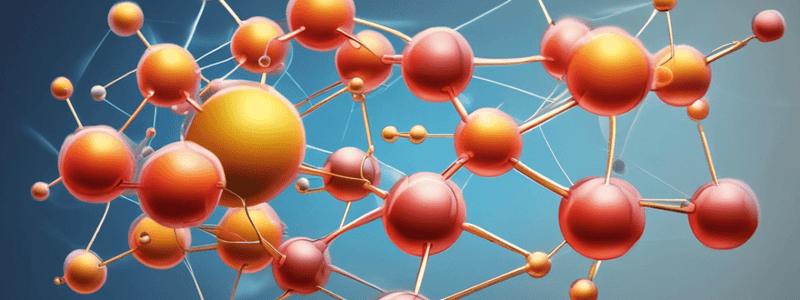Podcast
Questions and Answers
What is the basic unit of matter that cannot be divided into anything smaller?
What is the basic unit of matter that cannot be divided into anything smaller?
- Macromolecule
- Molecule
- Cell
- Atom (correct)
What is the common element in all living organisms that plays an essential role in the structure of macromolecules?
What is the common element in all living organisms that plays an essential role in the structure of macromolecules?
- Oxygen
- Hydrogen
- Carbon (correct)
- Nitrogen
What is the term used to describe the process by which living organisms respond to internal or external environments?
What is the term used to describe the process by which living organisms respond to internal or external environments?
- Response to the environment (correct)
- Homeostasis
- Evolution
- Stimuli
What is the unit of measurement used to express the mass of an atom or molecule?
What is the unit of measurement used to express the mass of an atom or molecule?
What is the term used to describe the sum of the masses of all atoms present within a molecule?
What is the term used to describe the sum of the masses of all atoms present within a molecule?
What is the atomic mass unit of a water molecule?
What is the atomic mass unit of a water molecule?
What is the criteria that requires living organisms to maintain a stable internal environment?
What is the criteria that requires living organisms to maintain a stable internal environment?
What is the unit of measurement equal to one billionth of a meter?
What is the unit of measurement equal to one billionth of a meter?
What is the smallest unit of living matter that can exist independently?
What is the smallest unit of living matter that can exist independently?
What type of molecule is Oxygen (O2) an example of?
What type of molecule is Oxygen (O2) an example of?
What percentage of the human body's total mass is made up of water?
What percentage of the human body's total mass is made up of water?
What is the largest macromolecule in the human body in terms of mass?
What is the largest macromolecule in the human body in terms of mass?
What is the function of carbohydrates in the human body?
What is the function of carbohydrates in the human body?
What is the monomer of proteins?
What is the monomer of proteins?
What elements make up the molecule of water?
What elements make up the molecule of water?
Flashcards are hidden until you start studying
Study Notes
Molecules
- Molecules are formed when two or more atoms combine and become chemically bonded.
- Atoms of the same or different elements can bond to form molecules, such as O2 (oxygen) or H2O (water).
- Molecules are the building blocks of everything in the world, living and nonliving.
Characteristics of Living Organisms
- Eight criteria must be met to be considered a living organism: growth and development, evolution, response to the environment, comprised of cells, reproduction, genetic code, homeostasis, and obtaining and using energy.
- Living organisms range in size, from bacteria to blue whales, but all meet the above criteria.
Size of Molecules
- Molecules come in different shapes and sizes, making it difficult to determine their size.
- Molecular weight is used to measure the size of molecules, which is the sum of the mass of all atoms present within a molecule.
- Metric units such as nanometers (nm) and angstroms (Å) can also be used to measure molecules.
- 1 nm is equal to one billionth of a meter, and 1 Å is equal to one ten-billionth of a meter.
- Examples of molecular sizes: water molecule (0.27 nm), carbon atom (0.34 nm), coffee bean (96,000,000 nm), grain of rice (20,000,000 nm), and red blood cell (8,000 nm).
Types of Molecules
- Homonuclear diatomic molecules: bonding of two identical atoms, such as O2, H2, N2, F2, I2, Cl2, and Br2.
- Heteronuclear diatomic molecules: bonding of two different atoms, such as NaCl, HCl, CO, and NO.
Molecules in Living Things
- Water is the most abundant molecule in the human body, making up about 65% of its total mass.
- Common elements making up the human body include carbon, nitrogen, hydrogen, oxygen, and sulfur.
- Macromolecules in the body include proteins, lipids, carbohydrates, and nucleic acids.
- Proteins are the largest macromolecule, making up 20% of body weight, and are composed of carbon, hydrogen, oxygen, nitrogen, and sulfur.
- Carbohydrates are used for quick energy and are composed of carbon, hydrogen, and oxygen.
- Lipids are used to store energy and are composed of carbon, hydrogen, and oxygen.
- Nucleic acids (DNA and RNA) are responsible for storing and expressing genetic information and are composed of carbon, hydrogen, oxygen, phosphorus, and nitrogen.
Studying That Suits You
Use AI to generate personalized quizzes and flashcards to suit your learning preferences.




